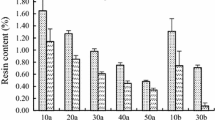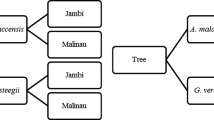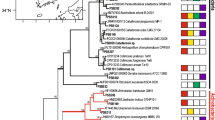Abstract
Agarwood is the most valuable resinous wood used in the production of products such as incenses, perfumes, and traditional medicines. However, such production has led to the destruction of wild Aquilaria forests. In the current study, an in vitro culture system was established by combining Aquilaria malaccensis with a quasi-symbiotic bacteria strain, A329, cultured on a medium designed for agarwood production. The quasi-symbiotic bacteria A329 derived from A. malaccensis agarwood has Bacillus-like characteristics, is low in phytopathogens, and can coculture with A. malaccensis with the current designed culture medium. The prolonged culture induced agarwood production at the base of A. malaccensis in vitro. Using high solid-phase microextraction gas chromatography-mass spectrometry, 23 compounds were tentatively identified, including several fingerprinting compounds, agarospirol, eudesmanes, guaianes, valencanes, selinenes, aristolone and 2-(2-phenylethyl) chromone. Using the in vitro system established in this study, the duration of agarwood resin formation can be shortened to 3 months in a well-controlled environment with 100% yield, constituting a promising platform with high commercial value for the selection of Aquilaria spp., the quasi-symbiotic microbes, and the combination of the two.




Similar content being viewed by others
References
Barden A, Anak NA, Mulliken T, Song M (2000) Heart of the matter: agarwood use and trade, and CITES implementation for Aquilaria malaccensis. TRAFFIC International, UK. http://www.traffic.org
Chen HQ, Wei JH, Yang JS, Zhang Z, Yang Y, Gao ZH, Gong B (2012) Chemical constituents of agarwood originating from the endemic genus Aquilaria plants. Chem Biodivers 9:236–250
Cui J, Wang C, Guo S, Yang L, Xiao P, Wang M (2003) Evaluation of fungus-induced agarwood from Aquilaria sinensis in China. Symbiosis 60:37–44
Espinoza EO, Lancaster CA, Kreitals NM, Hata M, Cody RB, Blanchette RA (2014) Distinguishing wild from cultivated agarwood (Aquilaria spp.) using direct analysis in real time and time of-flight mass spectrometry. Rapid Commun Mass Spectrom 28:281–289
Gamborg OL, Miller RA, Ojima K (1968) Nutrient requirements of suspension cultures of soybean root cells. Exp Cell Res 50:151–158
Gao X, Xie M, Liu SF, Guo XL, Chen XY, Zhong ZJ, Wang L, Zhang WM (2014) Chromatographic fingerprint analysis of metabolites in natural and artificial agarwood using gas chromatography–mass spectrometry combined with chemometric methods. J Chromatogr B 967:264–273
Grąbkowska R, Sitarek P, Wysokińska H (2014) Influence of thidiazuron (TDZ) pretreatment of shoot tips on shoot multiplication and ex vitro acclimatization of Harpagophytum procumbens. Acta Physiol Plant 36:1661–1672
Huetteman CA, Preece JE (1993) Thidiazuron: a potent cytokinin for woody plant tissue culture. Plant Cell Tissue Org Cult 33:105–119
Ismail N, Ali NAM, Jamil M, Rahiman MHF, Tajuddin SN, Taib MN (2014) A review study of agarwood oil and its quality analysis. Jumal Teknologi 68:37–42
Ito M, Okimoto KI, Yagura T, Honda G, Kiuchi F, Shimada Y (2005) Induction of sesquiterpenoid production by methyl jasmonate in Aquilaria sinensis cell suspension culture. J Essent Oil Res 17:175–180
Jayachandran K, Sekar I, Parthiba KT, Amirtham DA, Suresh KK (2014) Analysis of different grades of agarwood (Aquilaria malaccensis Lamk) oil through GC-MS. Indian J Nat Prod Resour 5:44–47
Kumar N, Reddy MP (2012) Thidiazuron (TDZ) induced plant regeneration from cotyledonary petiole explants of elite genotypes of Jatropha curcas: a candidate biodiesel plant. Ind Crop Prod 39:62–68
Lancaster C, Espinoza E (2012) Evaluating agarwood products for 2-(2-phenylethyl)chromones using direct analysis in real time time-of-flight mass spectrometry. Rapid Commun Mass Spectrom 26:2649–2656
Li W, Cai CH, Dong WH, Guo ZK, Wang H, Mei WL, Dai HF (2014) 2-(2-Phenylethyl)chromone derivatives from Chinese agarwood induced by artificial holing. Fitoterapia 98:117–123
Li W, Cai CH, Guo ZK, Wang H, Zuo WJ, Dong WH, Mei WL, Dai HF (2015) Five new eudesmane-type sesquiterpenoids from Chinese agarwood induced by artificial holing. Fitoterapia 100:44–49
Li Y, Sheng N, Wang L, Li S, Chen J, Lai X (2016) Analysis of 2-(2-phenylethyl)chromes by UPLC-ESI-QTOF-MS and multivariate statistical methods in wild and cultivated agarwood. Int J Mol Sci 17:771–791
Liu XM, Pijut PM (2008) Plant regeneration from in vitro leaves of mature black cherry (Prunus serotina). Plant Cell Tissue Org Cult 94:113–123
Lloyd G, McCown B (1980) Commercially feasible micropropagation of mountain laurel, kalmia latifolia, by use of shoot tip culture. Comb Proc Int Plant Prop Soc 30:421–427
Mei WL, Yang DL, Wang H, Yang JL, Zeng YB, Guo ZK, Dong WH, Li W, Dai HF (2013) Characterization and determination of 2-(2-phenylethyl)chromones in agarwood by GC-MS. Molecules 18:12324–12345
Mohamed R, Jong PL, Kamziah AK (2014) Fungal inoculation induces agarwood in young Aquilaria malaccensis trees in the nursery. J For Res 25:201–204
Murashige T, Skoog T (1962) A revised medium for rapid growth and bioassays with tobacco tissue cultures. Physiol Plant 15:473–497
Nurlaila I, Mohd HFR, Mohd NT, Mastura I, Seema Z, Saiful NT (2016) Analysis on Agarwood vapour using headspace volatile DVB-CAR-PDMS SPME with different sampling time. In: IEEE 7th control and system graduate research colloquium, pp 170–174
Okudera Y, Ito M (2009) Production of agarwood fragrant constituents in Aquilaria calli and cell suspension cultures. Plant Biotech 26:307–315
Oldfield S, Lusty C, MacKinven A (1998) The word list of threatened trees. World Conservation Press, UK
Qi SY (1995) III Aquilaria species: in vitro culture and the production of eaglewood (agarwood). In: Bajaji YPS (ed) Biotechnology in agriculture and forestry, vol 33, Medicine and aromatic plant VIII. Springer, Berlin, pp 36–46
Qi SY, He ML, Lin LD, Zhang CH, Hu LJ, Zhang HZ (2005) Production of 2-(2-phenylethyl) chromones in cell suspension cultures of Aquilaria sinensis. Plant Cell Tissue Org Cult 83:217–221
Subasinghe SMCUP., Hettiarachchi DS (2015) Characterisation of agarwood type resin of Gyrinops walla Gaertn growing in selected populations in Sri Lanka. Ind Crop Prod 69:76–79
Sulaiman N, Idayu MI, Ramlan AZ, Ali NAM (2015) Effects of extraction methods on yield and chemical compounds of gaharu (Aquilaria malaccensis). J Trop For Sci 27:413–419
Tamuli P, Boruah P, Nath SC, Leclercq P (2005) Essential oil of eaglewood tree: a product of pathogenesis. J Essent Oil Res 17:601–604
Wong YF, Chin ST, Perlmutter P, Marriott PJ (2015) Evaluation of comprehensive two-dimensional gas chromatography with accurate mass time-of-flight mass spectrometry for the metabolic profiling of plant–fungus interaction in Aquilaria malaccensis. J Chromatogr A 1387:104–115
Xu L, Liu GF, Bao MZ (2007) Adventitious shoot regeneration from in vitro leaves of formosan sweetgum (Liquidambar formosana L.). HortSci 42:721–723
Yang L, Qiao LR, Xie D, Yuan YH, Chen NH, Dai JG, Guo SX (2012) 2-(2-Phenylethyl)chromones from Chinese eaglewood. Phytochemistry 76:92–97
Yang DL, Wang H, Gua ZK, Li W, Mei WL, Gai HF (2014) Fragrant agarofuran and eremophilane sesquiterpenes in agarwood ‘Qi-Nan’ from Aquilaria sinensis. Phytochem Lett 8:121–125
Yucesan B, Turker A, Gurel E (2007) TDZ-induced high frequency plant regeneration through multiple shoot formation in witloof chicory (Cichorium intybus L.). Plant Cell Tissue Org Cult 91:243–250
Author information
Authors and Affiliations
Contributions
J-PC: Study initial conception and design, Critical revision. J-PC and K-HC: Acquisition of data, analysis and interpretation of data, drafting of manuscript.
Corresponding author
Ethics declarations
Conflict of interest
All author declares that they have no conflict of interest to disclose.
Additional information
Communicated by Sergio J. Ochatt.
Rights and permissions
About this article
Cite this article
Chung, JP., Chen, KH. Developing an in vitro quasi-symbiotic culture system of Aquilaria malaccensis with potentially beneficial microbes on agarwood resinous formation. Plant Cell Tiss Organ Cult 133, 193–202 (2018). https://doi.org/10.1007/s11240-017-1372-7
Received:
Accepted:
Published:
Issue Date:
DOI: https://doi.org/10.1007/s11240-017-1372-7




